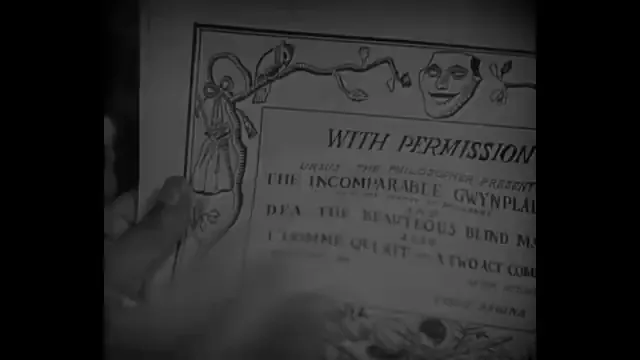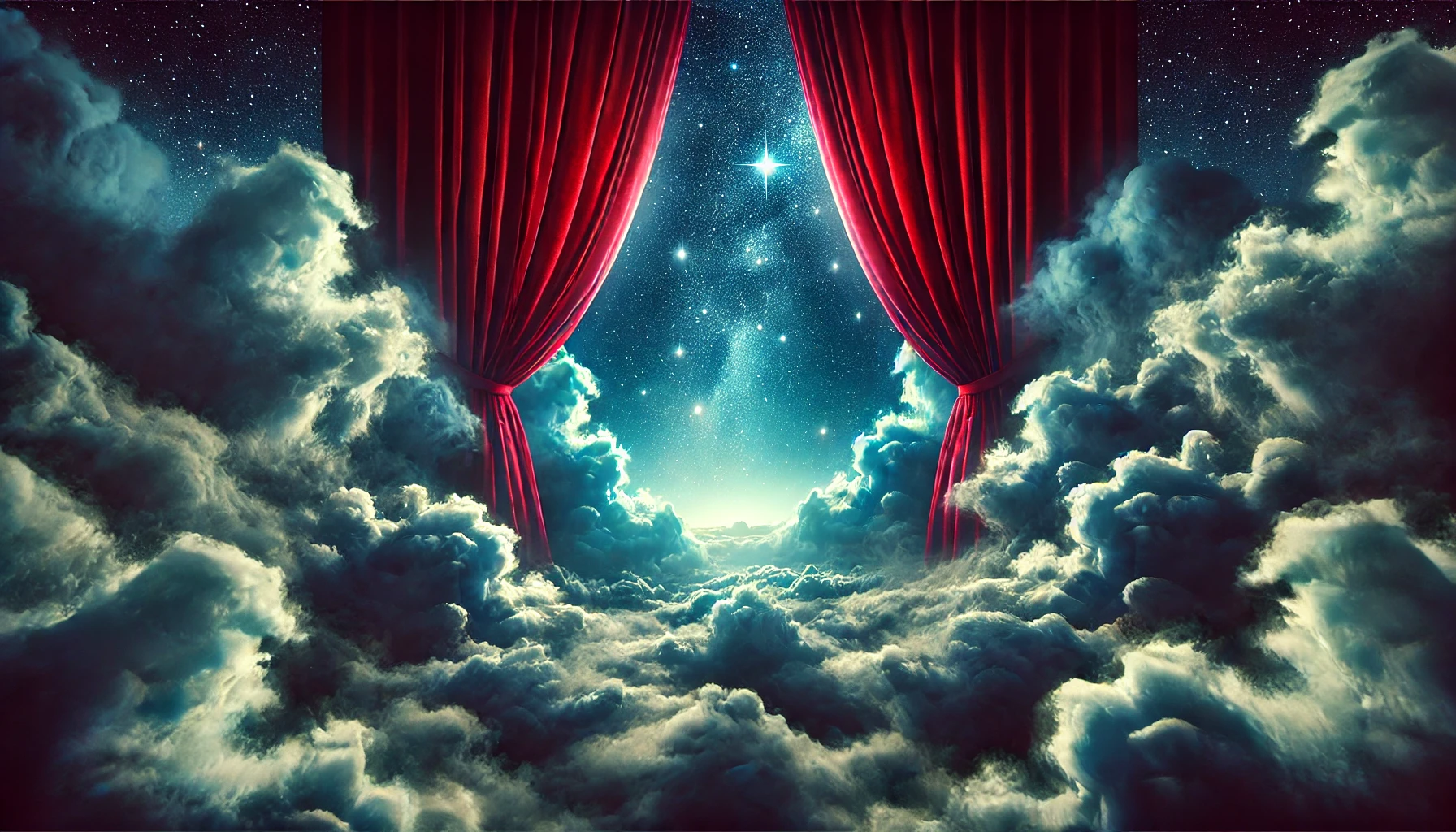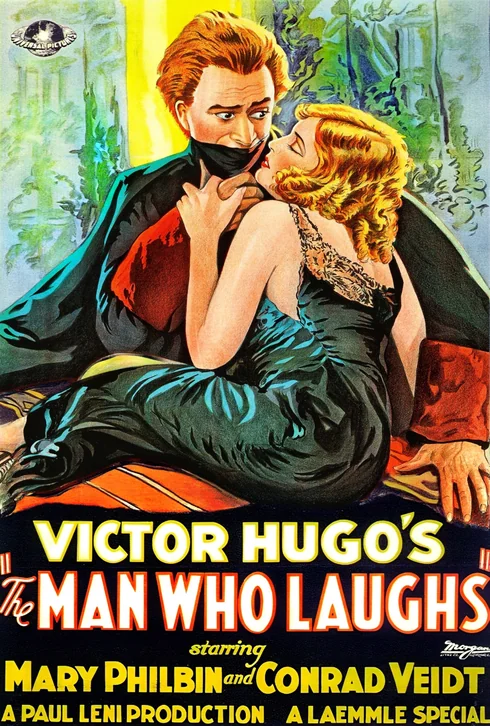🎯 Quick Overview
Trailer
- Director: Paul Leni
- Genre: Drama, Horror, Romance, Silent Film
- Release year: 1928
- Runtime (length): 1h 50min
- IMDb rating: 7.6/10 (8.7K votes)
- Rotten Tomatoes: 100%
😅 Plot Summary – Badly Explained
A nobleman’s son gets a permanent smile carved onto his face and becomes a TikTok influencer in ye olde times.
🍿 The Man Who Laughs: Detailed Plot Synopsis
The King’s Cruelty and Gwynplaine’s Disfigurement
In 17th-century England, Lord Clancharlie incurs the wrath of King James II for refusing to kiss his hand. As punishment, the King orders the nobleman’s execution and his young son, Gwynplaine, is sold to Comprachicos, a group of travelling child-buyers. The Comprachicos surgically carve a permanent, grotesque grin onto Gwynplaine’s face, leaving him disfigured and abandoned. Left to wander in the harsh winter, Gwynplaine stumbles upon a dead woman holding an infant girl. He rescues the baby, later named Dea, who is blind. Together, they find shelter with Ursus, a travelling philosopher and showman, who takes them in and becomes their caretaker.

Life as a Carnival Performer
Years pass, and Gwynplaine, Dea, and Ursus form a travelling carnival act. Gwynplaine, now known as ‘The Laughing Man,’ becomes a popular attraction due to his permanently grinning face. Dea, unable to see his disfigurement, loves Gwynplaine for his kind heart and gentle nature. Gwynplaine struggles with his appearance, feeling unworthy of Dea’s love and tormented by the laughter and stares of the crowds. Despite his inner turmoil, he continues to perform, providing for Dea and Ursus.

Royal Intrigue and a Duchess’s Desire
Gwynplaine’s performances catch the attention of Duchess Josiana, a bored and rebellious noblewoman. She becomes fascinated by Gwynplaine’s unique appearance and pursues him, much to the dismay of Queen Anne and her jester, Barkilphedro. Meanwhile, Barkilphedro uncovers Gwynplaine’s true identity as the rightful heir to a noble title, setting in motion a series of events that threaten to tear Gwynplaine, Dea, and Ursus apart. The Queen plans to use Gwynplaine as a pawn in her political games.

⚠️ Spoilers and Ending Explained
🎬 Cast & Characters
- Gwynplaine (Conrad Veidt): The Man Who Laughs, Gwynplaine is a nobleman’s son with a surgically-carved grin, struggling to find love and acceptance despite his disfigurement.
- Dea (Mary Philbin): Dea is a beautiful blind woman who loves Gwynplaine for his inner goodness, unaffected by his outward appearance.
- Ursus (Cesare Gravina): Ursus is a kind-hearted philosopher and showman who adopts and raises Gwynplaine and Dea, providing them with love and support.
- Duchess Josiana (Olga Baclanova): Duchess Josiana is a seductive and rebellious aristocrat who becomes entangled with Gwynplaine, drawn to his unique appearance and story.
- Barkilphedro (Brandon Hurst): Barkilphedro is a scheming and malevolent jester who seeks to exploit Gwynplaine’s identity for his own gain.
- King James II (Sam De Grasse): King James II is a despotic ruler who orders the disfigurement of Gwynplaine as revenge against his father.
💬 Memorable Quotes
- Gwynplaine: “A king made me a clown! A queen made me a Peer! But first, God made me a man!” – Gwynplaine declares his humanity before the House of Lords, asserting his identity beyond his forced roles.
- Dea: “I do not need eyes to see you.” – Dea expresses her love for Gwynplaine beyond his physical appearance.
- Ursus: “The king had his laugh made, God made mine.” – Ursus emphasizes that it is better to laugh naturally then unnaturally
💰Box Office
- Budget: $800,000 (estimated)
- Domestic Gross: N/A
- Worldwide Gross: $4,347
💥 The Man Who Laughs Reviews
Personal Review
I was absolutely mesmerized by ‘The Man Who Laughs.’ Conrad Veidt’s performance as Gwynplaine is heartbreakingly beautiful. The way he conveys such deep sadness and longing with just his eyes, despite that fixed smile, is incredible. The scene where Dea touches his face for the first time is so tender and emotional; I actually teared up. It’s a story about love, acceptance, and finding beauty where others see only horror. This movie will stay with me for a long time.
- Who would enjoy:
- “Fans of silent films”
- “Viewers interested in classic cinema”
- “Those who appreciate German Expressionist film style”
- “People who enjoy melodramatic stories”
- “Those interested in the origins of The Joker character”
- Content warnings ⚠:
- “Disturbing imagery (facial disfigurement)”
- “Themes of social injustice”
- “Brief nudity”
Professional Reviews
- CBR: “An underrated horror film from the silent era. Veidt’s portrayal of inner turmoil behind the forced smile is captivating. A movie that explores themes of class, privilege, and the perception of beauty. A significant piece of film history that deserves recognition and a remake.
- Amazon Reviewer: “Paul Leni’s direction emphasizes human values, sustaining intense moments for all his actors. Though the female roles are conventional, Veidt’s authentic performance transfixes, making it more than a simple martyr. The French Revolution spirit is in the air, making it a visually striking film.
Audience Reactions
Viewers were moved by the love story between Gwynplaine and Dea and by their heart-rending interactions.: The overall visual experience, supported by an emotional score, gave viewers an impactful story, told effectively through silent movie magic.
Overall Consensus: A silent era masterpiece highlighted by Veidt’s performance, and directing, resulting in great storytelling, though marred by dated elements.
Awards
🛠️ Behind the Scenes
- “Conrad Veidt’s grotesque grin was achieved through a combination of makeup and a dental appliance that stretched his lips into a perpetual smile. This made it difficult for him to speak, which ironically suited the silent film format.”
- “The film’s visual style, heavily influenced by German Expressionism, was initially criticized by American audiences for being too dark and unconventional.”
- “Bob Kane, the creator of Batman, cited Gwynplaine’s appearance as a direct inspiration for the Joker’s distinctive look.”
🖥️ How to Watch The Man Who Laughs?
As a silent film, ‘The Man Who Laughs’ may be available on various streaming platforms offering classic cinema. Check services like Criterion Channel, or explore rental/purchase options on platforms like Apple TV and Amazon Prime Video. Availability may vary by region.

🎥 Similar Movies
If you enjoyed The Man Who Laughs, you might like these similar films:
- The Hunchback of Notre Dame (1923): Another silent film adaptation of a Victor Hugo novel featuring a character with a physical deformity and themes of love and societal prejudice.
- The Phantom of the Opera (1925): Like ‘The Man Who Laughs,’ it explores themes of physical disfigurement, unrequited love, and the tragic figure of a misunderstood outcast.
- Joker (2019): Modern re-imagining of similar themes about society creating a monster.
- Freaks (1932): A pre-code drama that explores themes of appearance, acceptance, and revenge within a community of sideshow performers.
🛒 The Man Who Laughs Related Products
- Batman: The Joker 80th Anniversary 100-Page Super Spectacular: Celebrate the Joker’s 80th anniversary with this 100-page comic book special! Explore the Joker’s evolution and his most memorable crimes.
- DC Collectibles Batman: Arkham Asylum The Joker Action Figure: A highly detailed action figure of The Joker from the Arkham Asylum video game series.
- Batman: Arkham Knight (PS4): Experience the ultimate Batman experience in Arkham Knight, featuring the Joker as a key antagonist.
- The Man Who Laughs (1928) Movie Poster: A high-quality reproduction of the original theatrical poster for The Man Who Laughs.
🎧 Soundtrack
The Man Who Laughs features a captivating soundtrack that enhances the movie’s atmosphere and emotional impact. Here are some notable tracks:
You can find the complete soundtrack on Amazon Music and Apple Music.
🤨 FAQ
Gwynplaine’s distinctive appearance in ‘The Man Who Laughs,’ particularly his surgically carved grin, served as a major visual inspiration for the creation of the Joker, Batman’s iconic nemesis. Bob Kane, one of Batman’s creators, acknowledged the film’s influence on the character’s design.
While ‘The Man Who Laughs’ contains elements of the grotesque and macabre, it’s primarily a melodrama with themes of romance, tragedy, and social commentary. It’s often miscategorized as horror due to Gwynplaine’s disfigured face, but the film focuses more on his emotional journey and the societal injustices he faces.
The film explores themes of inner beauty, social injustice, and the corrupting influence of power. It highlights the importance of love and acceptance in a world that often judges individuals based on their outward appearance. Gwynplaine’s journey emphasizes that true value lies within, not in wealth, status, or physical perfection.
🔥 Bonus Content
The man who laughed at her went to burn the boiler .#movie #film #short
Want to see the most memorable scene from ‘The Man Who Laughs’? This short clip perfectly captures the tragic beauty of the film, you can see why this movie is so impactful!
Origin Of The Batman Who Laughs (Evil Batman Joker)
Ever wonder where the inspiration for the super villain ‘The Batman Who Laughs’ came from? Check out this video that breaks down the connection to ‘The Man Who Laughs’ – it’s wild how much they have in common!
✨ Rate
There are no reviews yet. Be the first one to write one.





